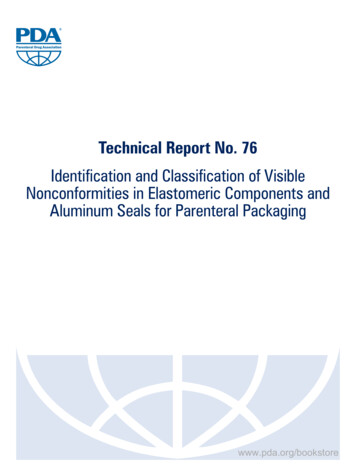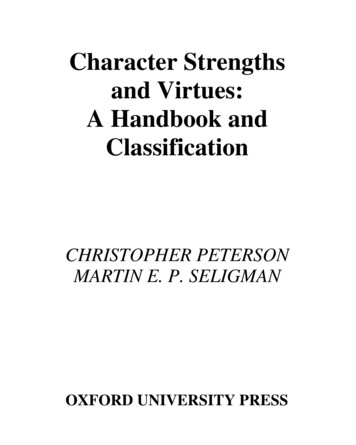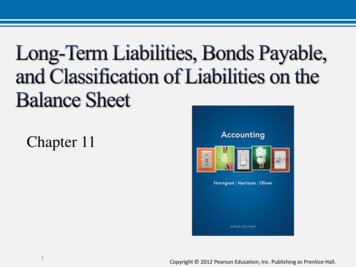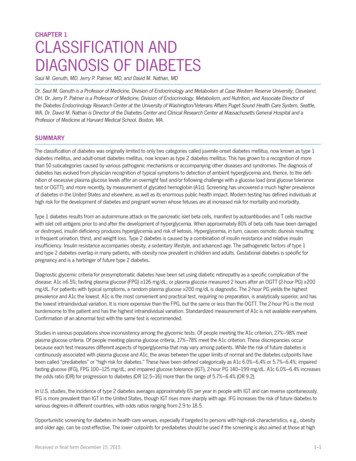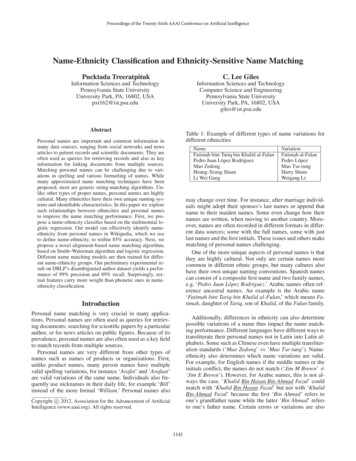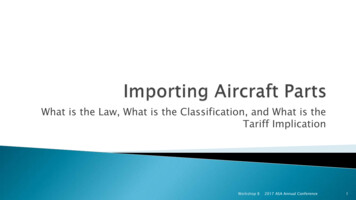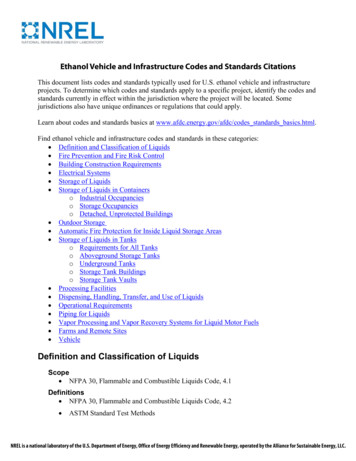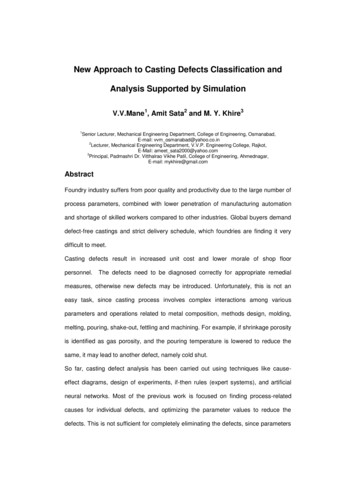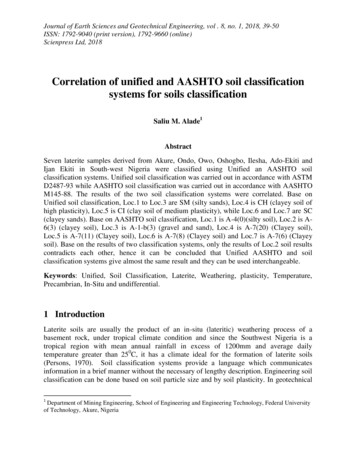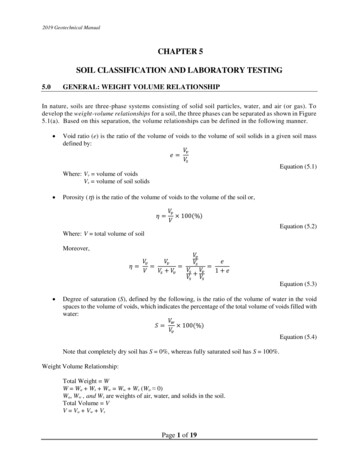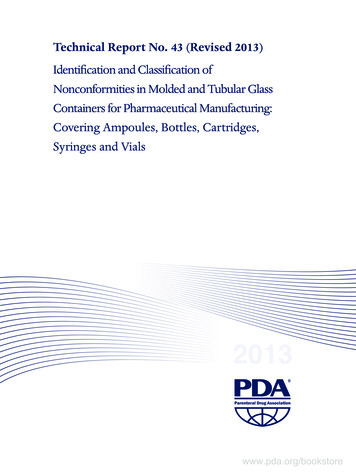
Transcription
Technical Report No. 43 (Revised 2013)Identification and Classification ofNonconformities in Molded and Tubular GlassContainers for Pharmaceutical Manufacturing:Covering Ampoules, Bottles, Cartridges,Syringes and VialsBethesda Towers4350 East West HighwaySuite 200Bethesda,MD 20814 USAwww.pda.org/bookstoreTel: 1 (301) 656-5900
PDA Identification and Classification of Nonconformities in Molded and Tubular Glass Containersfor Pharmaceutical Manufacturing: Covering Ampoules, Bottles, Cartridges, Syringes and VialsTechnical Report TeamAuthorsNicholas R. DeBello, Wheaton Industries Inc. (Co-Chair)Linda Lesh, Nipro Glass AmericasMichael N. Eakins, PhD, Eakins & Associates (Co-Chair)Kevin McLean, SGD North AmericaRoger Asselta, Genesis Packaging TechnologiesMichael McMaster, Gerresheimer Glass Inc.(Syringe Subteam Chair)Sarvang Mishra, Biogen Idec Inc.Luis Baez, PhD, Amgen Inc.Thomas Pamukcoglu, Medimmune LLCKevin Bailey, Assem-Pak, Inc.Anthony Perry, Schott North America, Inc.Anthony Bantug, Baxter Healthcare Corp.(Vial Subteam Chair)John Berggren, Reokace with SiO2 Medical ProductsAlfred B. Breunig, Nipro Glass Germany AGJuan Cerdan-Diaz, PhD, Nipro Glass AmericasStuart Chambers, GE HealthcareJack Cheeseman, Gerresheimer Glass Inc.David Davidow, Davidow and AssociatesMads Espersen, Novo Nordisk A/SWesley Prais, BD Medical-Pharmaceutical SystemsScott Ramseyer, CLS BehringMarkus Riffel, Vetter Pharma-Fertigung GmbH & Co. KGKishan Rijal, PhD, Sanofi PasteurTilman Roedle, Vetter Pharma-Fertigung GmbH &Co. KGSuzanne Seeley, Merck & Company, Inc.Chris A. Sellards, Schott North America, Inc.Peter Gassmann, PhD, Cilag AGBarbara H. Sneade, Grifols Therapeutics Inc.Stanley B. Hall, Pfizer Inc. (retired)Rob Swift, Amgen Inc.Rick Heckaman, Heckaman & AssociatesLi-Chun Tsou, PhD, Merck & Company, Inc.Hans Thomas Hemrich, Sanofi-AventisDavid Walker, PhD, Merck & Company, Inc.Raj Jani, Baxter Healthcare CorporationDavid Weiser, Schott North America, Inc.Alessandro Landi, Stevanato GroupHans Woerder, Hawe Packing ConsultingMark Leney, PhD, MassBiologicsKirk Wolff, Eli Lilly and CompanyDisclaimer: The content and views expressed in this Technical Report are the result of a consensus achieved by theauthorizing technical report team members and are not necessarily views of the organizations they represent.www.pda.org/bookstore
Identification andClassification ofNonconformities in Moldedand Tubular Glass Containersfor PharmaceuticalManufacturing:Covering Ampoules, Bottles,Cartridges, Syringes and VialsTechnical Report No. 43 (Revised 2013)ISBN: 978-0-939459-59-9 2013 Parenteral Drug Association, Inc.All rights reserved.Bethesda Towers4350 East West HighwaySuite 200Bethesda, MD 20814 USATel: 1 (301) 656-5900Fax: 1 (301) 986-0296E-mail: info@pda.orgWeb site: www.pda.orgwww.pda.org/bookstore
Table of Contents1.0 Introduction.11.1 Purpose and Scope. 12.0 Glossary of Terms.23.0 Glass Container ConformanceSpecification Development Process.43.1 Glass Container Dimensional Development. 43.2 Glass Container Sampling. 43.2.1 Definition of Lots. 53.2.2 Sampling Plans. 53.2.2.1 Continuous Sampling. 63.2.2.2 Lot-to-Lot Sampling. 63.2.2.3 Defective Parts Per Million . 73.2.3 AQLs. 74.2.1 Vials. 164.2.2 Ampoules. 214.2.3 Cartridges. 254.2.4 Syringes. 304.3 Reinspection of Glass Containers. 344.4 Documentation and Training. 345.0 Conclusion.356.0 Appendices.366.16.26.36.46.5Molded Glass Container Lexicon.36Tubular Glass Container Lexicon: Vials.70Tubular Glass Container Lexicon: Ampoules.98Tubular Glass Container Lexicon: Cartridges.129Tubular Glass Container Lexicon: Syringes.1554.0 Glass Nonconformities Lexicons.107.0 References.1824.1 Molded Glass Container Lexicon. 104.2 Tubular Glass Container Lexicons. 168.0 Additional Reading.183Figures and Tables IndexTable 3.2.3-1Examples of True AQL Values for Accepton Zero, Reject on One. Pa 95%. 8Figure 4.2.2-2 Tubular Glass Ampoules Lexicon:Example B. 25Table 4.1-1Molded Glass Container Lexicon: Bottlesand Vials. 11Table 4.2.3-1Figure 4.1-1 Molded Bottle Lexicon Example A. 15Figure 4.1-2 Molded Bottle Lexicon Example B. 15Table 4.2.1-1Tubular Glass Container Lexicon:Vials. 16Figure 4.2.1-1 Tubular Vials Lexicon Example A. 20Figure 4.2.1-2 Tubular Vials Lexicon Example B. 20Tubular Glass Container Lexicon:Cartridges. 26Figure 4.2.3-1 Tubular Glass Cartridge Lexicon:Example A. 29Figure 4.2.3-2 Tubular Glass Cartridge Lexicon:Example B. 29Table 4.2.4-1Tubular Glass Container Lexicon:Syringes. 30Tubular Glass Container Lexicon:Ampoules. 21Figure 4.2.4-1 Tubular Glass Syringe Lexicon:Example A. 33Figure 4.2.2-1 Tubular Glass Ampoules LexiconExample A. 25Figure 4.2.4-2 Tubular Glass Syringe Lexicon:Example B. 33Table 4.2.2-1www.pda.org/bookstore
1.0 IntroductionPharmaceutical and biopharmaceutical companies and glass manufacturers have made quality decisions based on visual inspections of glass containers without the aid of universal guidelines orstandards. Inconsistency in defining glass-container nonconformities has resulted in a lack of clarity within the pharmaceutical/biopharmaceutical industry. This inconsistency has also resulted ina non-uniform approach in meeting regulatory expectations to deliver high-quality pharmaceuticalproducts.PDA members recognized the need to provide guidance for the identification and classification ofglass-container nonconformities in the form of a consensus-based technical report. A Technical Report Team was formed to represent a broad cross-section of glass and pharmaceutical manufacturingprofessionals and to create a consensus document.This document provides an approach to a quality decision-making process and represents best practices for identification and classification of visual nonconformities for glass containers.1.1Purpose and ScopeThe standardized quality criteria in this document are intended as guidance for component manufacturers and for incoming inspection at pharmaceutical companies. While the defect identificationwill remain the same, the quality criteria used for filled containers will likely differ. Five detailed lexicons (Appendices 6.1-6.5) that visually illustrate glass nonconformities have been developed: one formolded glass bottles and vials and four for tubular glass vials, ampoules, cartridges, and syringes. Thephotographs and drawings for the molded and tubular glass containers in this technical report and thelexicons were collected by the glass task force subteams.The identification and classification of glass imperfections represent only a part of the overall criteria,which include, but are not limited to, adherence to dimensional standards, an incoming lot sampling program, acceptable quality limits, and reinspection. This technical report provides the buildingblocks for developing an overall supplier quality agreement for these glass containers.These guidelines are not intended to establish mandatory standards for classification and identification of glass nonconformities; they are intended to be a single-source overview that complementsexisting guidelines and standards or documents listed in the reference section. For greater detail onvarious topics throughout this technical report, additional reading has been provided. It is alwaysadvisable to consult with the appropriate regulatory authorities for agreement on the strategies employed for identification and classification of visual nonconformities of glass containers.Technical Report No. 43 (Revised 2013) www.pda.org/bookstore1 2013 Parenteral Drug Association, Inc.
Roger Asselta, Genesis Packaging Technologies (Syringe Subteam Chair) Luis Baez, PhD, Amgen Inc. Kevin Bailey, Assem-Pak, Inc. Anthony Bantug, Baxter Healthcare Corp. John Berggren, Reokace with SiO2 Medical Products Alfred B. Breunig, Nipro Glass Germany AG Juan Cerdan-Diaz,
